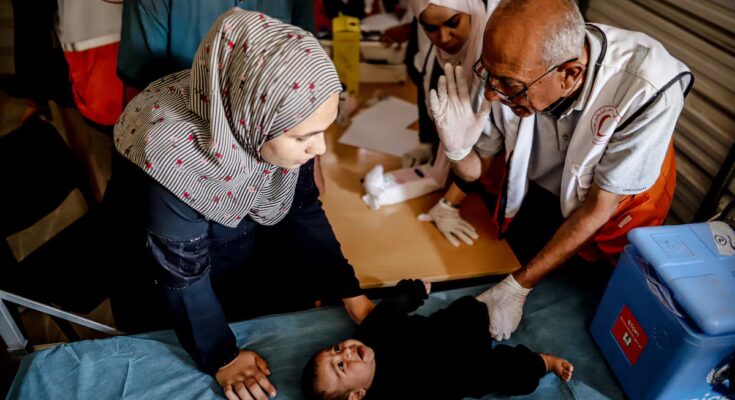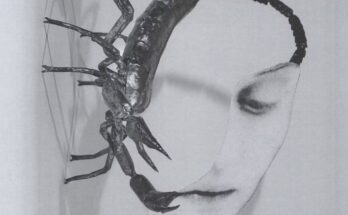The ceasefire in Gaza agreed a month ago by Israel and Hamas has not allowed Mohammed al Zuhairi, 78, to obtain drugs to treat his chronic asthma. “Not even the inhaler I used is available in Gaza. They give me painkillers, but no real cure,” says this man, father of five children and grandfather of 30 grandchildren – two of whom died during the war – who had to move from Tal al Zaatar, in the north, to central Gaza. Health authorities have reported that drugs for this lung disease, and many others, remain unavailable.
Al Zuhairi has also not recently received tents, tarpaulins or baskets with food, despite the fact that winter is upon us and the condition of an asthmatic person worsens with the cold and if he does not eat properly. “I only find food in a nearby soup kitchen,” he says. In a few days his son Iyad, 44, will become a father. “We expected an improvement in our living conditions, but nothing has changed,” he laments.
The United Nations count indicates that 18 of the Strip’s 36 hospitals are currently partially operational. Four of them managed to open after the ceasefire came into force. Additionally, WHO reported that there are seven centers that care for children with severe acute malnutrition. According to their estimates, there are around 25,000 children under the age of five in Gaza who need urgent medical care due to malnutrition.
According to Zaher al Waheedi, director of the Health Information Center of the Ministry of Health of the Strip, where the Islamist movement Hamas has governed since 2007, there is no improvement in the health sector one month after the ceasefire came into force. According to the manager, between 10 and 15 people die every day due to the lack of available medical services.
Al Waheedi explains, for example, that in recent weeks, out-of-stock medicines have increased from 54% to 55%. The shortage of basic medicines reaches 56%, which means that half of patients with chronic diseases (heart disease, diabetes, hypertension) do not receive regular treatment. In emergencies, the lack of medicines reaches 38%, an “unprecedented and dangerous” rate for services that welcome the largest number of patients, according to Al Waheedi.
According to Gaza ministry sources, no MRI machines are working in Gaza after Israeli forces destroyed or deactivated seven devices. Of the 17 CT scanners, only six work. In this context, Al Waheedi is skeptical about the next phase of the ceasefire. “Everything is very confusing because the politicians themselves do not have a clear vision. We cannot predict or expect what the situation will be like.”
“Healthcare personnel are extremely exhausted. We have lost 1,722 professionals, the occupation has arrested 361 and 440 have left Gaza,” says Al Waheedi, revealing the urgent need for specialized medical delegations.
In the north, warns Caroline Seguin, emergency coordinator of Doctors Without Borders in the Gaza Strip, the situation is particularly critical due to the level of destruction. “The hospitals are not functioning at all. In Gaza City there are still some hospitals that are functioning at half capacity, but all of them have suffered partial destruction. There is a lack of primary care services and, of course, secondary care as well,” he explains.
The healthcare sector has not seen the expected improvement and no real or fundamental change has occurred in its reality.
Zaher al Waheedi, director of the Health Information Center of the Ministry of Health
UNFPA, the United Nations sexual and reproductive health agency, warned in July that pregnant women and newborns in Gaza are facing “catastrophic” conditions due to the collapse of Gaza’s health system, stress and food deprivation. At the time, it was estimated that the lack of essential medicines and the destruction of hospitals had reduced critical neonatal care by 70%.
In the case of cancer patients, 67% of the necessary drugs and treatments are not available. According to the Palestinian Center for Human Rights (PCHR), there were around 12,500 people with cancer in Gaza before the war broke out. In May, chemotherapy was completely suspended in the Strip after the European Hospital was rendered inoperative after being targeted by Israeli attacks, and minimal chemotherapy services have been provided at the Nasser Hospital since then.
Gaza also lacks basic materials such as syringes, gloves and masks, as well as operating room and laboratory equipment, preventing vital tests from being carried out on chronic patients. In 2024, the Palestinian Ministry of Health estimated that approximately 350,000 people in Gaza suffering from chronic diseases such as diabetes, cancer, and cardiovascular, kidney, and respiratory disorders have been deprived of essential medical checks and care due to the war.
In parallel, Israel also limits the number of foreign medical missions entering Gaza and the number of patients who are evacuated for treatment abroad. Since the ceasefire came into force on October 10, only 165 people have been able to leave, according to WHO data. According to these sources, around 16,500 patients should be urgently evacuated to receive healthcare.
Patients leaving for treatment abroad through the Kerem Shalom border crossing with Israel fell to 43 children in two months, compared with about 100 monthly departures before the war.
According to Gaza ministry data, dialysis patients dropped from 1,244 to 622. Of those no longer receiving treatment, 43 died due to Israeli bombing, 44 left Gaza to receive treatment, and the rest died due to the inability to receive treatment.
US President Donald Trump’s Gaza plan, which served as the basis for truce negotiations between Hamas and Israel, envisages the arrival of a similar amount of humanitarian aid to the Strip as in the previous two-month ceasefire at the beginning of the year, when the daily flow fluctuated between 500 and 600 trucks. But these figures are not being reached and the humanitarian aid granted by Israel is not enough to meet the enormous needs, according to international and local humanitarian organizations.
Within the volume of aid entering Gaza, assistance allocated to the health sector is still clearly insufficient. For example, on November 11, more than 3,700 pallets of aid from United Nations entities were unloaded. According to data from the Office for the Coordination of Humanitarian Affairs (OCHA), 67% were food and only 1% were medical supplies.
According to these sources, since the ceasefire came into force, Israel has denied entry into Gaza of more than 6,490 tons of UN-coordinated humanitarian aid. Most of them contained medical supplies.
MSF confirms that it has managed to bring in some trucks with medicines, but that there are still many items that cannot enter due to Israeli control. “I am referring to equipment for performing CT scans, X-ray machines and also some important surgical equipment,” explains Seguin.
Asmaa al Helu, 39, walks slowly along Gaza’s Mediterranean coast carrying her children’s worn clothes after washing them in seawater. There is no fresh water available for washing clothes, dishes or bathing. Her three-year-old son Mahmoud, who still wets himself due to a recurring illness and a bad cold, needs clean clothes.
Al Helu’s bare feet sink into the sand. She is a divorced mother of 13 children – seven boys and six girls, the oldest being 19, Qusai – and has no source of income. Her ex-husband abandoned them without any help. He collapses in front of his tent, which he has surrounded with blankets and worn fabrics. Mahmoud jumps into his lap while nine of his children gather around him begging for bread or food. It’s almost noon and they haven’t eaten anything. “Nothing has changed for us, even though a month has passed since the ceasefire,” says Al Helu.
“I’m not strong and I can’t take it anymore,” says Al Helu. “I am forced to endure this situation that no human being can endure. I am very exhausted and dejected and would like to cry until I die. This is not life, this reality is similar to death.”



